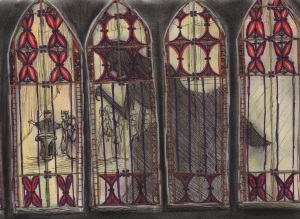by Matthew Roy, University of California Santa Barbara
Listen to the Suite here, and investigate more below:
MacDonald’s vividly grotesque witch ranks “among the most extravagant fairy tale villains” (see Pazdziora on Chapter 2) as he presents us with a character that we love to hate. As a composer it proved very tempting to succumb to this collective and associative “Hiss!” by dressing Makemnoit in all the spiteful regalia of musical ugliness. But it quickly becomes evident that such an approach would fail to adequately express the complexities of MacDonald’s witch.
Makemnoit is not a pure embodiment of evil, like, say, Tolkien’s Sauron. MacDonald problematizes her character by highlighting her familial and socio-economic relationships with the protagonists (see Chapter 2). Not only is she family, the King’s sister and the Princess’ aunt, but she is also monetarily impoverished and socially marginalized. It is difficult not to feel a twinge of discomfort when MacDonald (a man who knew only too well the stigma of being poor) draws our attention to these humanizing factors. This generic transgression of expectations requires that the musicalization of Makemnoit not lose sight of her humanity, however distant or faint, in the midst of her twisted wickedness. It is a problem very similar to the one encountered in composing for the story’s heroine (see the commentary on The Princess https://subvertinglaughter.wordpress.com/2014/01/13/tlpsprincess/), but with one important difference: the humanity of the Princess struggles to overcome the curse in the light of the story’s redemptive cure; on the other hand, the humanity of Princess Makemnoit remains forever in the parenthetical past. She has whole-heartedly embraced the “Dark Side”.

Chapter Two: ‘Won’t I, Just?’ ‘After waiting and waiting in vain for an invitation, she made up her mind at last to go without one, and make the whole family miserable, like a princess as she was.’
I musically ground Makemnoit’s human character through reference to a traditional dance. The “sarabande” was a Central American/Spanish dance that became part of European court culture in the seventeenth century and was characterized by a slow rhythm in triple meter. (In 1706 Friedrich Erhardt Niedt considered it a “gravitätischer, langsahmer Danz”, ideal for Makenmnoit, a witch who “knew all the ins and outs of the laws of gravitation as well as the ins and outs of her boot-lace”.) Upon this slow and methodical musical foundation, the witch’s wickedness has room to brood and cackle.
For the musical embodiment of evil, one really need look no further than twentieth-century modernist techniques with its melodic disjunction, harmonic dissonance, and rhythmic violence. The compositions of Arnold Schoenberg potently demonstrate the discomforting effect of this music (see his expressionistic Pierrot Lunaire http://www.youtube.com/watch?v=pgO9svrzfkQ). At the heart of Schoenberg’s brutal aesthetic lies hostility, according to Theodor Adorno, hostility against autonomy, against society, and eventually against rationality itself (Adorno, 400). This perfectly characterizes Makemnoit’s self-involved hatred of order, of pleasure, and of history.
To use a technical term, this piece is “crunchy”. I explicitly demonstrate her hatred of “all the modes” by combining major and minor chords simultaneously (technically termed polytonality) on the second beat of the sarabande theme. A mysterious change at 0:51 could signify her descent beneath the lake, both in terms of texture (downward-falling chords in the right hand accompanied by a steady, puttering left hand) and in terms of abstract ritualization (repeated incantations, traced circles, locking and unlocking of doors, and the “click-clack” of Fury-esque knitting). The White Snake of Darkness makes it appearance in the wake of this ominous descent (1:46). Beginning as one slithering, chromatic line, additional voices emerge to create a writhing texture of dissonant polyphony. (Technically known as 12-tone or dodecaphonic composition, Schoenberg’s post-WWI recourse to mathematics as his justification for musical choices.) Makemnoit gleefully rejoices in the apocalyptic climax of the snake as her sarabande makes a gloriously ruckus, self-indulgent recapitulation (2:14). The final, disjunct cackle (3:04) separates us even further from Makemnoit’s humanity, ending the piece in a wash of brutal theatricality.
Works Cited:
Adorno, Theodor W. Essays on Music. trans. Susan H. Gillespie. Berkeley: University of California Press, 2002.
MacDonald, George. The Complete Fairy Tales. New York: Penguin Books, 1999.
Niedt, Friedrich Erhardt. Musicalische Handleitung II. Hamburg: Niedt and Schillern, 1706.

